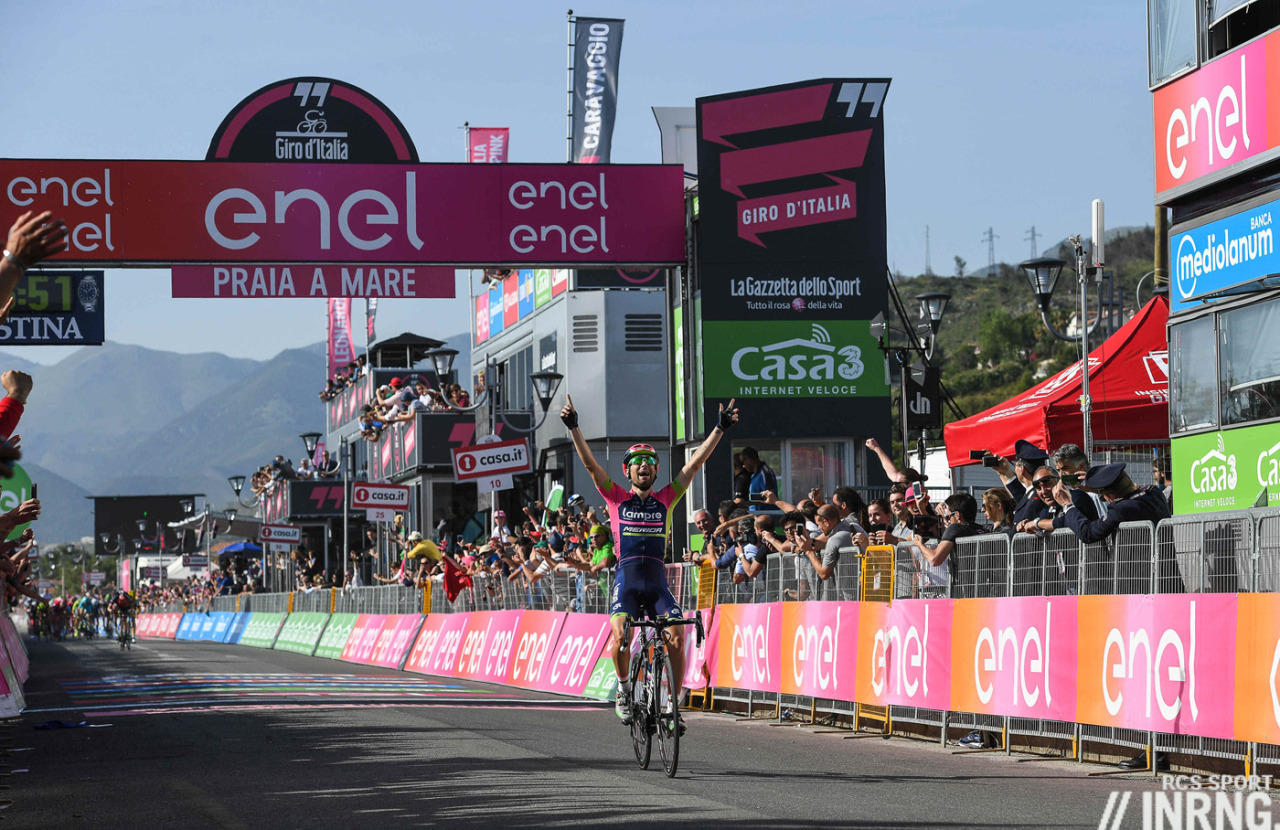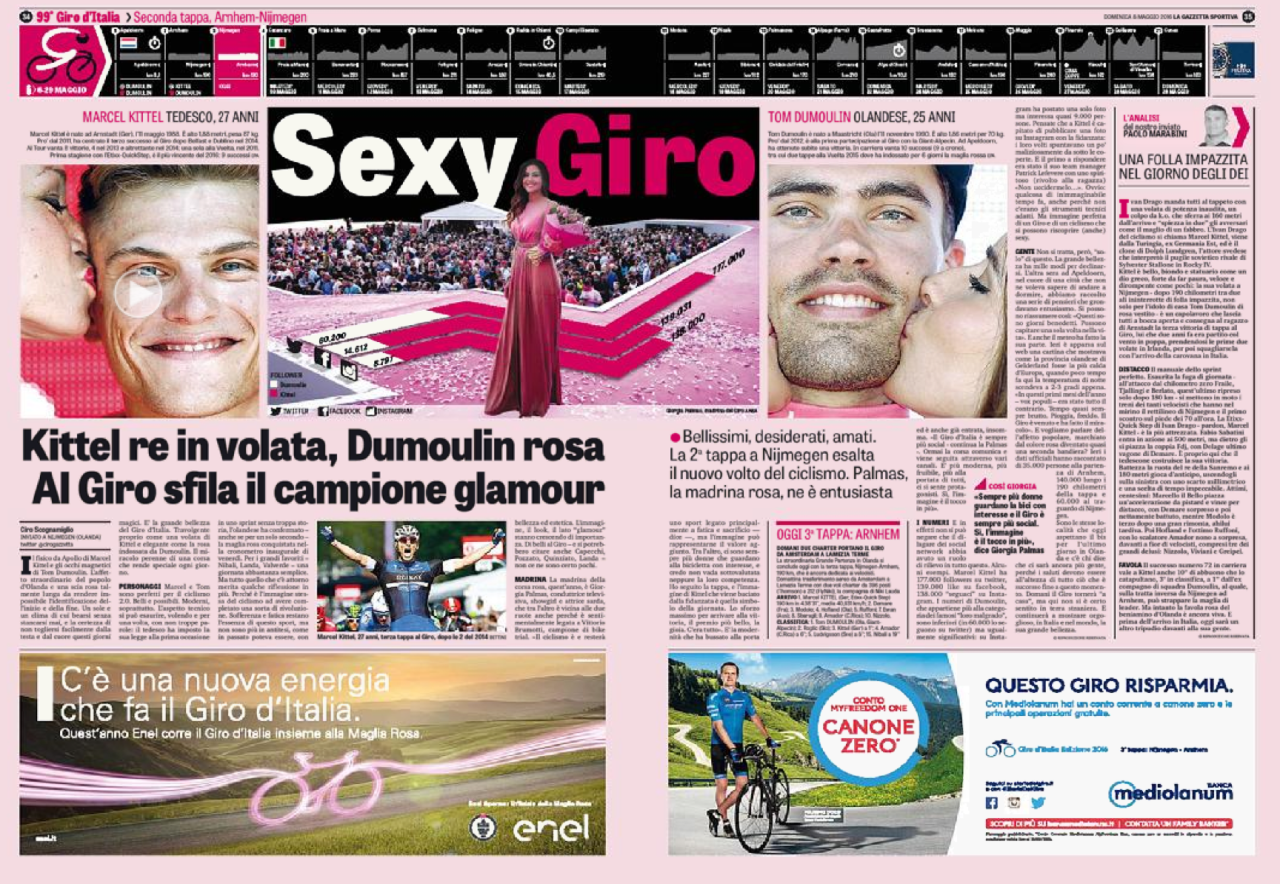Do you have a morning routine? With the Giro d’Italia on there’s nothing better than starting the day with some Italian coffee and La Gazzzetta Dello Sport, the official newspaper of the Giro. Here’s a look at the newspaper, it’s history and what it’s like to read.
The Early Days
The Gazzetta Dello Sport was born in 1896 from the merger of La Tripletta and Il Ciclista. It was printed on green paper but in 1899 the paper switched to pink. The Giro d’Italia was first run in 1909 but it wasn’t until 1931 that a pink jersey was awarded, copying the practice of the yellow jersey in the Tour which reflected the yellow pages of L’Auto, the French newspaper behind the race that has become L’Equipe today.
Today La Gazzetta, like its French sister, rose to prominence thanks to its cycling past and is still linked to running the national tour as part of RCS Media, just as L’Equipe is part of the Groupe Amaury which also owns ASO who run the Tour de France. Circulation levels are comparable too with about 250,000 print copies a day. So far, so similar but La Gazzetta is part of a larger Italian media empire RCS which owns foreign publications like Spanish sports daily Marca and sizeable publishing empire. By contrast Amaury has been selling off its print assets – like the Le Parisien newspaper to luxury goods stable LVMH – to focus on events. There’s talk L’Equipe could be sold too. So if newspaper had a similar start, riding the tide of cycling’s popularity to become a sports daily staple and creating their national grand tour today they occupy different roles.
However the Gazzetta feels closer to the Giro than the Tour, its logo is all over the Giro in a way that the L’Equipe is not at the Tour, similarly reading the Gazzetta feels a lot more like reading the race newspaper with the same sponsors of the race taking out ads and so on. Spot the Gazzetta logo below…

Sometimes your wrists ache as you turn the countless pages of football to reach the cycling coverage. La Gazzetta seems to fit in 20-25 pages of football a day right now, half the paper and the cycling fan quickly learns to open the paper midway. Of course even if the soccer season is ending there’s no end to the coverage with news on the national squad, player transfers, team updates and more. Even during the Giro it’s hard for cycling to make the front page, Diego Ulissi’s win yesterday just made the corner of the front page and last Saturday’s edition had twice as many pages about a tennis tournament in Rome as it did on cycling despite the Giro’s start.
It’s not just a sports paper, there is news and entertainment at the back. One of La Gazzetta’s best cycling writers Pier Bergonzi, a director of the paper, also has a column about wine. All this helps make La Gazzetta Italy’s most read newspaper, you can buy it for the sport but get news and even classified ads in there too.

The cycling coverage is good but not outstanding. There’s all the information you need to understand the Giro, whether a review of the previous day’s stage, an interview with a rider and all the current standings. A lot of the content relates to the previous day’s stage which almost feels like old news by the time you start the new day but the print (and digital edition) have far more content that the Gazzetta website. Today’s newspaper has a two page spread on “Two hearts and one saddle” about married couples in professional cycling worthy of a celebrity magazine; a theme this week has been Marcel Kittel’s sex appeal. One small observation is the regular reference to a rider’s home region for example Diego Ulissi is “the Livornese” as he’s from near Livorno, Damiano Cunego the Veronese and so on. It’s a challenge to find an Italian cyclist mentioned without a nod to their home but this isn’t a house style, it’s universal in Italy.

At times the Gazzetta does things other newspapers won’t. Marco Pantani is a regular too, his death replayed over and over again including bizarre cartoon depictions of an alleged murder. Or take the claims of Michele Ferrari visiting the Astana team camp which emerged in late 2014. The paper said it had photos… only it never printed them. Speaking to The Cycling Podcast the newspaper’s reporter Ciro Sconomiglio hinted at a race against La Repubblica, another newspaper. Perhaps Gazzetta wanted to be first with the news or to spike a rival’s story, it’s not clear but it meant Gazzetta ran with a story and never followed up with the proof necessary to validate it. This gossipy side often means the paper is the first to launch transfer news, a staple of the football pages.
It’s essential reading during the Giro if only because you can find so many of the stories, quotes and information in one place rather than navigating around several websites to get your fill of cycling news. The paper has a large staff of cycling writers and it shows, especially this month. At €1.50 it’s not cheap but visit a cafe and it’s often supplied on the counter.
Conclusion
La Gazzetta and an espresso are inalienable combination during the mornings of May. The newspaper created the Giro and the race and paper remain closely linked assets in RCS Media’s portfolio although the paper obviously thrives off its football coverage. Reach the cycling pages and it’s sometimes the first with the transfer news, proving there’s still a place for print media in the age of the web given the newspaper’s ability to hold on to good stories. Sometimes this goes too far, they print things other papers that Het Nieuwsblad or L’Equipe might not. The paper is dominated by football even when the football has stopped but the Giro’s calendar slot means cycling gets a window as the Italian league ends. Essential reading? Yes.


An interesting insight. My current morning routine is reading this very blog and the unmissable stage summaries and previews that are currently within!
Somewhat surprising that cycling doesn’t take a little more prominance in Gazzetta at this time of year, it doesn’t sound a million miles away from the UK, where I’ve long since given up searching the sport sections of national newspapers in favour of various online reads instead. Perhaps I should consider learning a new language and a move to Belgium, that seems the only place where the cycling outstrips the football for coverage and insight.
This.
Add in a hot mug of freshly roasted and ground Congolese beans and water, the windows open to the Spring air (finally!) and you can have your Eyetaliano cafe thing!
Readers of a certain age in the UK and Ireland may get flashbacks to James Richardson presenting Football Italia on Channel 4 when they see the opening photo.
I thought the same! Can even here the tune in my head.
A nice little nod to cycling with the Segafredo cup, with the Trek-Segafredo team.
‘Gooooooollllazzooooooo’
First ever game was Samp v Lazio
0-0 well into the second half and I switched over. Game finished 3-3.
I’m not bitter…
I do love buying a copy of gazzetta or l’equipe when abroad, pretending I understand it…
I must admit paying little attention to La Gazzetta at euro 1.50 a copy, except when I’m going to see an Italian bike race in-person. Then it can be hard to actually find a copy for sale on the race route – I’ve lost count of the times we’ve rolled up to a newsstand and found them sold-out! It’s a must-have for me on race day.
On the other hand, one of the best things in print in Italy is BICISPORT magazine, especially their GUIDA del GIRO, another publication that tends to be sold-out anywhere near the Corsa Rosa route. In addition to the course map and elevation profile, you get the timetable so you know where to be and when. The icing on the cake is the little food section, featuring the best gastronomy of each region. Stage 5’s finish in Benevento features the region’s TORRONE, a must, says Bicisport. English-speakers could get Bicisport via I-pad in English at one time, though I don’t know if that’s still the case?
“similarly reading the Gazzetta feels a lot more like reading the race newspaper with the same sponsors of the race taking out ads and so on.”
This is part of the strategy of RCS “commercial division” which sells ads and sponsorship across their various platforms and publications (RCS Sport is involved in many types of sports). They create packages to generate more impressions, greater brand association, and broaden appeal, and of course to up sell and contribute to their bottom line.
A successful sponsorship investment doesn’t end when the check is written to the event or team; that is merely the beginning. What one does surrounding that sponsorship is often what provides the return on investment, as sponsorship is essentially buying the rights to use the event/team in one’s marketing efforts.
There is nothing quite like reading a newspaper! I have not actually bought one for several years now, I am sadly a sign of the times.
The joy of reading a newspaper with a morning coffee on a Saturday morning is just out of this world! Loved this article though.
Regards,
Faisal
http://www.velosimplissime.com
I’d really love a paper like this in the UK… Maybe just on a Saturday, oh and if it has to have 20 pages of football there should be a law that only 5 of them could be about the Premier League…
Cycling reporting is pretty poor on average in the uk mainstream press. They can manage Wiggo and Cav, and the olympics, but that’s about it with one or two exceptions.
What went pink first, the FT or Gazzetta?
FT went pink in 1893. So half a decade before the La Gazzetta
+1 for Ciro!
I recall, Before the internet all we had for cycling news was VeloNews on news print. 35 years ago.
It was at least 30 days behind what was actually happening.
My first exposure to pro cycling growing up in rural Australia, other than highlights of the Tour, was second and even third hand copies of VeloNews that were passed between one cycling nut and the next. Reporting on races that happened a couple of months ago but it was gripping nonetheless. Unthinkable today…
The Spanish papers also refer to riders (and athletes in general) by their region of origin. Quaint.
I also like La Gazzetta’s obsession with everyone’s age, and that being featured in every photo caption.
That tends to be a general journalistic obsession. No matter the story, any UK paper will introduce a quote with the person’s name and age, and sometimes where they are from.
I’ve obviously been reading the wrong papers! ?
How was the coffee?
French TV commentators and sports journalists regularly refer to sportsmen by their town or place of origin. Laurent Jalabert was “le Mazametan,” and Richard Virenque was “le Varois,” for example. HWMNBN, when he wasn’t “l’extra-terrestre” was sometimes simply “le Texan.” In Switzerland, I noted during the recent Tour de Romandie that Thibaut Pinot is “le Comptois.”
One of the highlights for me of the Giro would be reading GDS, via their digital shop. I’ve got a rough understanding of Italian, so I’d download the paper as a PDF and read it offline, taking my time to understand some of the nuances of the writing. However, this year, I’ve been unable to do this as someone in management has stopped the PDF download function, thereby buggering up my enjoyment. I’m not going to pay for something I can’t keep hold of myself, so it’s arrivederci from me to GDS for the time being.